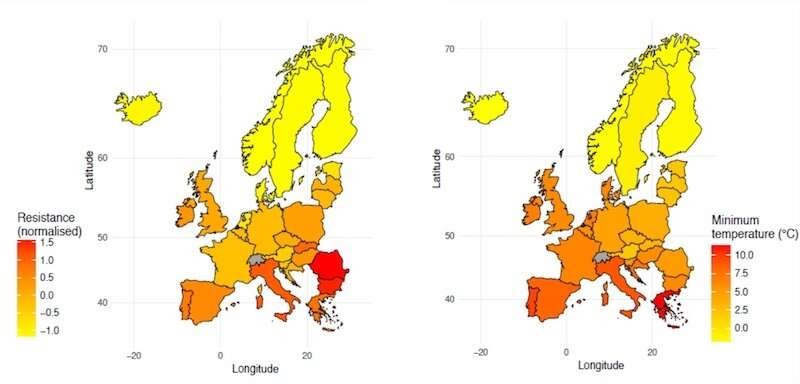A new study suggests that there may be a link between rising temperatures due to climate change and antibiotic resistance.
—
The research team from the Boston Children’s Hospital Computational Health Informatics Program (CHIP) analysed national surveillance data from 28 European countries, incorporating test results from more than 4 million patients. They analysed the prevalence of antibiotic resistance over time, focusing on three common bacteria (Escherichia coli, Klebsiella pneumoniae, and Staphylococcus aureus). They also gathered European temperature data from European and US sources.

Maps of 28 European countries illustrate the average increases in antibiotic resistance for three common pathogens (at left), and the annual average minimum temperature (at right) between 2000 and 2016 (Credit: Sarah McGough, Boston Children’s Hospital).
What is Happening?
- Southern European countries with minimum temperatures that were 10°C warmer due to climate change- like Spain, Portugal, Romania and Italy- recorded a more rapid rise in antibiotic resistance over time than cooler northern European countries like Sweden, Finland and Norway. The increases in resistance ranged from 0.33 to 1.2% per year, even after accounting for factors like local population density and local patterns of antibiotic use.
Mauricio Santillana, one of the authors of the report who is also affiliated with Harvard Medical School and the Harvard T.H. Chan School of Public Health, says, “Our longitudinal study is the first to show that European countries with warmer ambient minimum temperature have had more acute increases in antibiotic resistance over the last 17 years. This observation helps explain the geographic differences in antibiotic resistance documented in other cross-sectional studies. Such resistance could eventually render our most effective antibiotic agents obsolete.”
You might also like: Deforestation in Brazilian Amazon Soars to a 12-Year High
Why Would Temperature Affect Antibiotic Resistance?
- While the researchers acknowledged that temperature and antibiotic resistance increases could have changed independently of each other, they detailed some potential ways that temperature could affect antibiotic resistance.
- For example, in-vitro experiments provide evidence that bacterial growth increases at warm temperatures, which could facilitate transmission of resistant strains. Higher temperatures could also enhance transfer of antibiotic resistance genes between bacteria.
To examine the link further, the researchers have called for similar long-term studies to be conducted in the US to monitor temperature and antibiotic resistance in different regions of the country over time. They say, “Our findings may motivate future research to better understand biological mechanisms or human behaviour patterns, such as farming practices, that may occur in warmer locations and may have facilitated the rapid increase of antibiotic-resistant bacterial strain.”
Derek R. MacFadden, one of the study co-authors, adds, “A better characterisation of the genetic and biological factors that may contribute to the increased spread of antibiotic-resistant strains may help us better design public health and specific clinical interventions.”

















